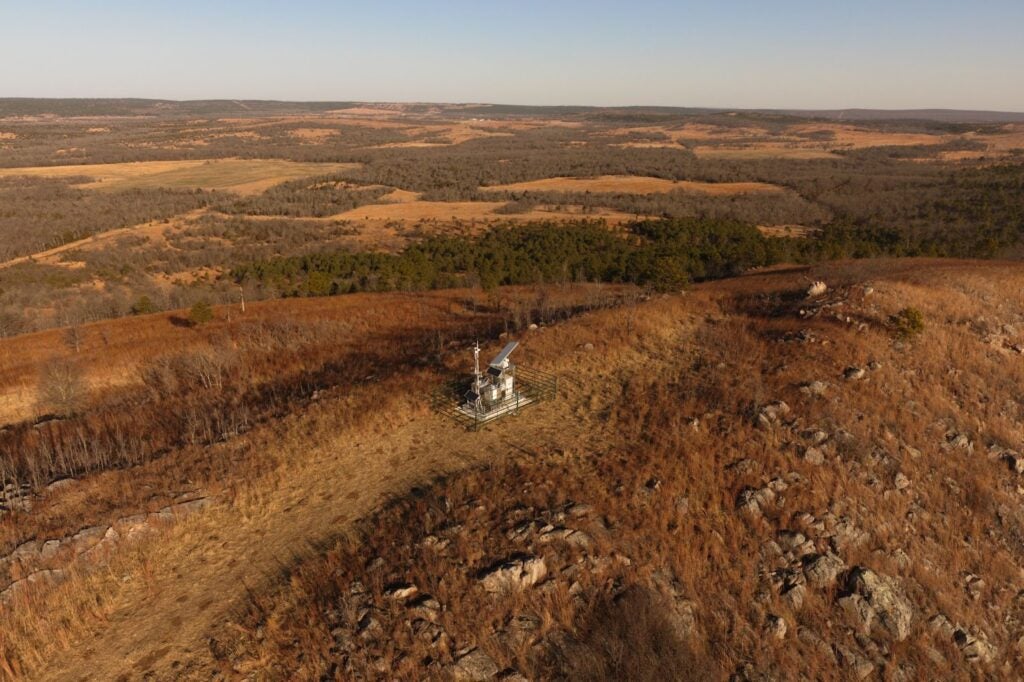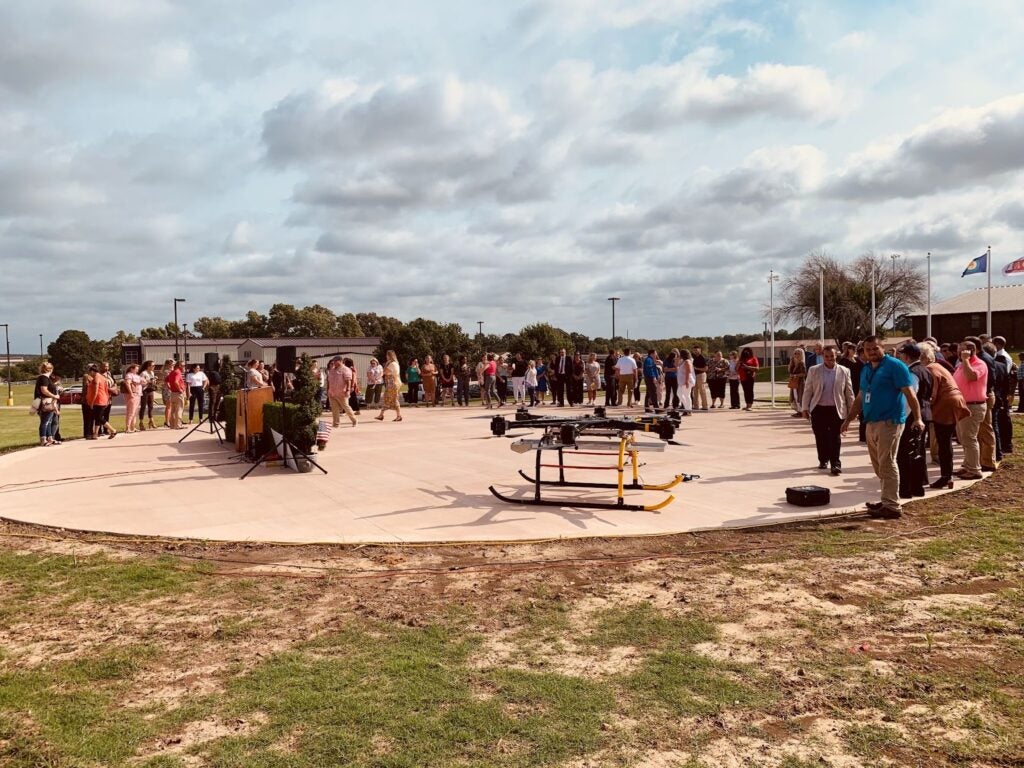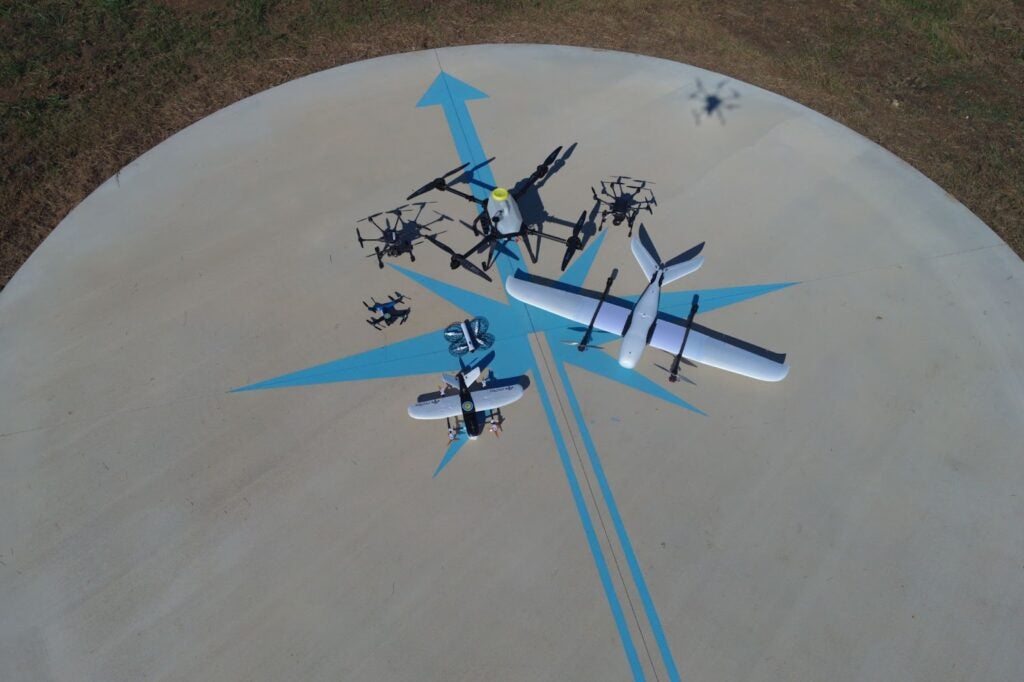Editor’s Note: This article originally appeared on FreightWaves.com.
As James Grimsley walked to high school through the small town of Atoka, he had no choice other than to take in the natural beauty—rolling hills, evergreen trees, big blue skies.
Atoka, a town of 3,000 tucked away within the Choctaw Nation reservation in Oklahoma, is still the place Grimsley calls home more than three decades later. But today, hidden within the 11,000-square-mile parcel of land, is one of the largest drone delivery testing sites in the world.
“Here, in rural southeastern Oklahoma, on a reservation, we have a front-row seat to what the future of that technology is going to look like,” Grimsley told Modern Shipper. “We’re seeing systems fly for the first time. We’re seeing these operations happen here that will probably be commonplace in the future, but they’re not commonplace now.”
Life on the Reservation
For as long as Grimsley can remember, life on the reservation was tough. During the Trail of Tears ethnic cleansing campaign from 1831 to 1850, the Choctaw people were the first to be forcibly removed from their ancestral homelands, which covered parts of current-day Mississippi, Louisiana, Alabama, and Arkansas.
Since then, the tribe has been impoverished, relying largely on agriculture, casinos, and government work to keep its economy afloat. Because the tribe’s businesses receive little in the way of federal funding, a large chunk of the revenue it produces typically gets funneled back into local businesses and stimulus projects.

“It was a very impoverished area with generational poverty, but they’re very kind,” Grimsley said. “There was always that sense of altruism and taking care of the community.”
Still, Grimsley explained, if you found a way out, you typically went off to college. That’s exactly what he did after graduating high school, earning a bachelor’s degree in aerospace engineering, and a master’s in technical engineering from the University of Oklahoma. He was the first member of his family to graduate from college.
Moving back to the reservation was never in Grimsley’s plan, he said. He would spend the next 35 years working various jobs in aviation, including some work with commercial drones. But in 2016, Grimsley received a phone call that would change his mind.
Getting the Call
While working as the associate vice president of research at OU, Grimsley picked up the phone and was greeted by a few familiar voices. It was some old friends he grew up with in Atoka, now working for the tribal government, and they had a proposition.
They explained that the Choctaw Nation had bought a 44,500-acre parcel of land and were looking for something innovative it could do with it without destroying it. Their solution? To use the property as a testing ground for advanced aviation and drone delivery.

Initially, Grimsley was skeptical. But he called a friend who worked at NASA to see if he could make inroads with other agencies. A week later, he got a call back letting him know that the federal government had strong interest in working with the tribe, seeing it as a way to get around some of the industry’s regulatory hurdles, particularly those surrounding automated takeoff and landing and flights beyond the pilot’s visual line of sight (BVLOS).
Soon after, Grimsley learned of the Federal Aviation Administration’s plan to launch the Integration Pilot Program (IPP), an initiative designed to speed the adoption of drones into U.S. airspace. The tribe commissioned him to research and report on the potential impacts of the program, and in 2017 the Choctaw Nation became one of nine IPP participants.
“When they won that designation, that’s when it became apparent that I should leave my university position and do this full time,” Grimsley recalled.
Upon returning to the reservation, things had changed. While he was away, there had been a major economic turnaround for the tribe. It had lowered its unemployment rate from double digits to below 4 percent and living conditions had improved.
However, Grimsley, a transportation commissioner for the area, believed drone delivery could unlock a new level of safety and economic growth. He cited an alarming statistic: 35 percent of the U.S. population lives in rural areas, yet 65 percent of traffic fatalities happen in those regions. Introducing drone delivery could reduce the tribe’s reliance on those roads and highways.
Not only that, but adding another layer of transportation could open the economy to new goods and services.
“We’re seeing this as something that will help us with public safety coupled with opportunity,” Grimsley said. “A lot of the delivery we’re looking at right now is health related—being able to connect clinics, as well as patients to clinics.”
But it didn’t matter how bullish Grimsley was on the program. He needed to get the Choctaw people on board with the plan in order to get it off the ground—and he wasn’t particularly hopeful.
“I always assumed the worst, that the public would not like this,” he said.
But that’s not what happened: “It was the opposite of that,” Grimsley continued. “People were like, ‘This is interesting. When will it happen? When will we get to see the benefits of drones?’”

With federal, tribal and civilian stakeholders aligned, Grimsley had the green light to turn the reservation into a hub for the technology of the future.
There’s Something in the Air
Today, the Choctaw Nation testing ground is one of the largest of its kind in the world, attracting hundreds of companies from around the globe.
But despite all that activity, Grimsley and the tribe have managed to keep the environmental impact nearly nonexistent. That’s because the program only uses about 35 acres of land for hangars and other facilities.
“We’re not really touching the rest of that 44,000 acres, and it’s one of the neatest ways that we can use this property because we’re not damaging it,” he said. “We’re flying mostly electric propulsion, so we’re not polluting. We’re not creating any noise situations. We’re not disturbing wildlife.”

Interested in getting in on the action? Good news: The tribe doesn’t have any hard criteria for who can participate in the program. It just asks that interested companies bring them a petition.
“We don’t want to be arrogant,” Grimsley said. “We don’t know everyone’s business case. We’re not necessarily predicting everything in the future. So we always ask people to start with a proposition—come bring us something, let’s talk about it.”
After receiving the petition, the tribe will consider things like necessary investments, on-site costs, job creation potential, and the possibility of the company relocating to the reservation. But the process is relatively lenient, designed to get as many drones in the sky as possible.
“We know that if we help advance the regulatory system, and we help with the rulemaking, we’re going to be helping ourselves as well,” Grimsley said.
Still, safety remains a priority. The Choctaw government has invested extensively in measures like ground-based radar and Automatic Dependent Surveillance-Broadcast (ADS-B) receiver networks, which use satellite navigation or other sensors to determine the position of an aircraft.
The Choctaw Nation also served on the board of the FAA’s BVLOS Advisory Rulemaking Committee, which in March recommended new regulations for drone flights that go beyond the line of sight of the operator.
The Aerial Corridor Ahead
In just a few short years, Grimsley has helped lift the program—and life on the reservation—to new heights.
“There was a net exit of people,” he said. “People were leaving. They weren’t coming here. We’ve stopped that. People are coming here, and the landscape in terms of opportunity, quality of life, quality of health—everything—has dramatically changed.”
The program has steadily taken on a life of its own, touching more than the 44,500-acre testing zone. It has helped stimulate STEM education, with schools all across the reservation—including the one in Grimsley’s native Atoka—adopting aviation programs and training the next generation of drone delivery experts. Kids are even able to tour the testing site and watch live demonstrations.
“It’s been remarkably successful, and that brought a lot of great recognition,” he said. “The reservation has been able to highlight the culture and just the type of people that are within the Choctaw Nation. They’re really good people—people who are very loyal. They’re hardworking, committed. It’s really shined a light on all of those kinds of virtues that really characterize the tribe itself.”
Even beyond that, though, the program has helped reinvigorate the Choctaw Nation’s economy, attracting companies to the reservation. That has transformed the tribe into the largest employer in southeastern Oklahoma and also contributed to the reservation’s $2.5 billion economic impact on the state in 2019.
But Grimsley has even bigger plans in mind, namely, a complete rethinking of the way Americans build and maintain transportation infrastructure.
“We just can’t continue to build highways and scale transportation like we always have,” he said. “It’s going to be hard. But I think we’re going to start to see more overlap between what we do on the ground and in the air.”
Instead of bringing up the quality of roads and highways facing ever-increasing capacity concerns, Grimsley proposes building a new layer of transportation altogether. That is, of course, drones, and he could see the program developing something like the U.K.’s 165-mile aerial drone corridor.
By adding another layer of transportation above ground-based corridors, Grimsley believes drone delivery can ease the burden facing roadways—and build a more equitable supply chain.
“In the 21st century United States of America, your ZIP code is still a strong predictor of your health outcomes, your access to opportunity, and just your general quality of life,” he said. “So your ZIP code basically gives us an indication of the type of infrastructure you’re going to have access to for transportation.”
That’s not the world Grimsley wants to live in. But he and the tribe have hope that drone delivery can help close the gap between the wealthiest ZIP codes and the most impoverished.
“One of the things you’ll see with the Choctaw Nation is that we look at things like this with the belief that the future is bright,” Grimsley said. “We believe that in the balance of things, things are going to be great.”
For more coverage on drone delivery logistics, go to Freightwaves.com.




